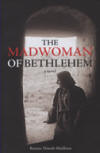The Madwoman of Bethlehem
Don’t let the title or shadowy sepia cover fool you; this is not your typical Middle Eastern novel: sad, dark, slow, un-relatable. There are no silent, dark-clad, wise old women or handsome, ruthless, old-fashioned, but still socially respectable young men. The plot isn’t made slow by verbally artistic renditions of the dusty scenery or groups of loyal women milling around the well. The tone is not sad in a “you’ll-never-know-what-it’s-like, feel-sorry-for-the-lot-of-us, but-our-life-is-beautiful,” distant kind of way.
Don’t let the title or shadowy sepia cover fool you; this is not your typical Middle Eastern novel: sad, dark, slow, un-relatable. There are no silent, dark-clad, wise old women or handsome, ruthless, old-fashioned, but still socially respectable young men. The plot isn’t made slow by verbally artistic renditions of the dusty scenery or groups of loyal women milling around the well. The tone is not sad in a “you’ll-never-know-what-it’s-like, feel-sorry-for-the-lot-of-us, but-our-life-is-beautiful,” distant kind of way.
It is often sad, and at times dark, but Bethlehem, Palestine native, Rosine Nimeh-Mailloux has written an honest novel. Her novel does not attempt to defend, explain or stereotype the culture and societal expectations of mid-twentieth century Bethlehem. In fact, she does just the opposite through the main character, Amal, the madwoman from the title.
Amal’s story is told through both first person and third person point of view. This was a genius and necessary decision on the part of Mrs. Nimeh-Mailloux.
Amal first speaks directly to us from the asylum. The book opens with an almost funny description of her life in the madhouse and descriptions of a few of the other inmates. Most importantly, Amal subtly relays to the reader that she is not mad; she only pretends. She explains to the reader how she stays safe and sane while playing the part of an inmate; Amal’s “golden rule” is “a little weeping, a little whimpering. Now giggling, then moaning. Laugh a little. Cry a little. Sing your heart out. Dance. Especially when the orderlies or nurses are around. But never let go completely.” The potential problem with a first person narrator (particularly one in a madhouse who claims sanity) is the ever popular unreliable narrator.
This is where the genius of the author comes in. When Amal isn’t speaking to us from the madhouse, Amal’s story is told from a completely omniscient point of view. The events that shaped Amal’s life and sent her to the madhouse are told from a source that is reliable. The narrator tells us exactly what happened, while relaying both Amal’s and other character’s thoughts and feelings as well. Combined with Amal’s own words from the asylum, the reader is left with no doubt as to the truth. We can let ourselves be completely absorbed by the novel.
And we are. The novel is full of emotion, sex, lies, gossip and manipulation, none of which is simply a selling point. Every sentence in the novel feels essential and full of depth. The story moves. The back and forth between present and past doesn’t feel forced, and we care equally about what is happening in the madhouse and what has already happened to Amal outside of the madhouse. Part of this is the mysterious reason that Amal decided it would be beneficial to feign insanity and be committed, and the unspoken “sin” she says could never be forgiven. Primarily, however, the reason I was driven to keep reading was the relationship I had developed with Amal.
A good novel makes a reader feel like they know a character. A great novel makes the reader care about the character in a way that affects the reader. A way that makes you think about yourself and makes you miss that relationship when the book is over. Despite the fact that Amal’s story takes place fifty years ago or that she grew up in a culture completely different than mine, I felt a connection with her. She was not a Middle Eastern woman; she was a woman. And I became not only a woman, but a Middle Eastern woman, in a way. I felt her anger and entrapment; I understood her bitterness.
Amal is an intriguing character. She is contradictory and inconsistent, all in a very consistent and realistic way. She is human. While Amal is the strong point in the novel, the driving force, within her also lies the fault of the novel. When the novel opens, she is very bitter and angry. When the novel closes, she is still very bitter and angry. In the very last chapter, Amal says, “The more I think about it, the more I am not certain I will ever be able to forgive my father.” She refers to her mother as a coward and shows no signs of even attempting understanding. There is no measurable growth. It makes the reader wonder, then, what is the point of telling the story? What has Amal learned from her nine years in the asylum? You think she will finally take responsibility for her own emotions, but she never does. And her newly discovered self reliance is questionable. While she ends the book with the strong statement, “I will rescue myself,” directly prior to that she claims the asylum as her home, saying she is surrounded by “protectors.”
While Amal’s lack of development is a disappointment, the rest of the novel was not. And perhaps the ending was intended by the author. She was, after all, very aware of her character and setting throughout The Madwoman of Bethlehem. Maybe it was just me, always looking for hope, blindly optimistic, like the young Amal.





